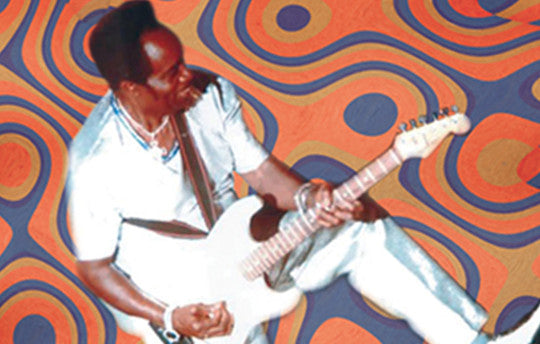Your Cart is Empty

Highlife – Ghana’s urban dance music – has had enormous influence throughout West Africa. In the early years of Ghana’s independence, it became the national music and one of the most popular, enduring and adaptable African styles.
Highlife Roots
Highlife began in the early twentieth century when African and European influences were combined with the Gold Coast’s local rhythms. The term highlife was coined in the 1920s and referred to the high-class dance evenings fashionable among the Ghanaian elite. Other proto-highlife forms included brass-band music, local drum and voice marching bands called konkoma, and palm wine guitar bands.
Koo Nimo is one of the last true veterans of highlife roots and palm-wine music, which dominated Ghana’s popular music scene throughout much of the twentieth century. By delving deep into Koo Nimo’s narrative style you can trace out the link to the melodious strains of Prince Nico Mbarga and, subsequently, the heady didactic Afrobeat of Fela Kuti, and even further to the current-day exponents of the highlifehip-hop fusion, hip-life.Nimo’s music effortlessly revives the beautiful roots of highlife once more. An album by Koo has been released on Riverboat Records in late July 2012.
 Koo Nimo is one of the last true veterans of highlife roots and palm-wine music, which dominated Ghana’s popular music scene throughout much of the twentieth century. Recorded in his backyard at home in Accra, expect acoustic guitars and rolling percussion all topped off with his gentle story-teller singing style.
Koo Nimo is one of the last true veterans of highlife roots and palm-wine music, which dominated Ghana’s popular music scene throughout much of the twentieth century. Recorded in his backyard at home in Accra, expect acoustic guitars and rolling percussion all topped off with his gentle story-teller singing style.
Dance-Band Highlife
During World War II, elements of swing and jazz were introduced and formed what is known as classic highlife. After the 1957 independence, the socialist-aligned government actively encouraged indigenous music and funded state bands.
E.T. Mensah and his band, Tempos, popularized highlife throughout West Africa. Another influential figure, Guy Warren, was responsible for introducing Afro-Cuban percussion and calypso.
By the late 1970s, however, dance-band highlife was on the way out, having been undermined by new, imported pop styles and a declining economy.
After World War II, palm wine bands evolved into bigger guitar-based bands. A key figure here was E.K. Nyame who grafted highlife onto Ghana’s popular vaudeville concert shows, “concert parties”. Between the 1950s and 1970s scores of bands were formed in the wake of his success.
 Highlife music conjures up images of African nightclubs, shiny dancefloors, champagne, fine clothes and the spirit of hope and expectation that marked the end of the colonial era. The heyday of highlife was in the 1960s and 1970s, and the name describes and defines the popular guitar-led dance music of West Africa, primarily from Ghana and Nigeria. The Rough Guide To Highlife surveys this vibrant scene, featuring classic tracks of the era and the biggest artists within the genre.
Highlife music conjures up images of African nightclubs, shiny dancefloors, champagne, fine clothes and the spirit of hope and expectation that marked the end of the colonial era. The heyday of highlife was in the 1960s and 1970s, and the name describes and defines the popular guitar-led dance music of West Africa, primarily from Ghana and Nigeria. The Rough Guide To Highlife surveys this vibrant scene, featuring classic tracks of the era and the biggest artists within the genre.
During the 1960s, highlife was influenced by Congolese music, pop, and soul. The new era of experimentation in the early 1970s led to the creation of Afro-rock, Afro-beat and Afro-funk. The new wave included the groups Osibisa, Magic Aliens, and Boombaya.
Another initiative was the Ga cultural revival spearheaded by the troupe Wulomei. These groups were characterized by powerful Ga drumming, female harmonies and exciting floor shows.
After 1966, Ghana began a downward spiral of political and economic instability. Musicians suffered and many left to work abroad.
In the 1930s all the country’s top musicians made the pilgrimage to studios in London and several ended up settling there. The 1980s saw another wave of musicians and added to the growing interest in African music.
In the 1980s, Ghanaians began to focus on Germany. Here, highlife was being fused with funk and rock to produce a new, harder-edged, studio sound. Other countries that artist made overseas connections with include Canada, Holland, Sweden, and the US.
Gospel and reggae were the new musical forces in the 1980s. By the 1990s, there were an estimated 800 gospel groups, many playing a variant of highlife. The gospel revolution allowed a substantial number of women to enter the popular music arena.
Reggae struck a chord throughout Ghana in the late 1970s and 1980s and still shows no signs of abating. A key reggae-highlife figure is Amekye Dede, who became the most popular musician in Ghana by the 1990s.
In the mid-1990s local version of hip-hop and rap became known as “hiplife”. Hiplife is known for its controversial lyrics and American-style clothing. In the 1970s and 1980s, the live popular music scene collapsed and without the easy-to-produce electronic music of hiplife, the urban youth would not have an artist voice.
The 1990s also saw a resurgence of traditional Ghanaian music. Foreign interest in local Ghanaian music has led to a blossoming of folkloric and neotraditional ensembles. The Ghanaian kpanlogo drum has seen particular popularity internationally.
You can now study these genres through our partner site World Music Method. Click HERE to view the list of courses.